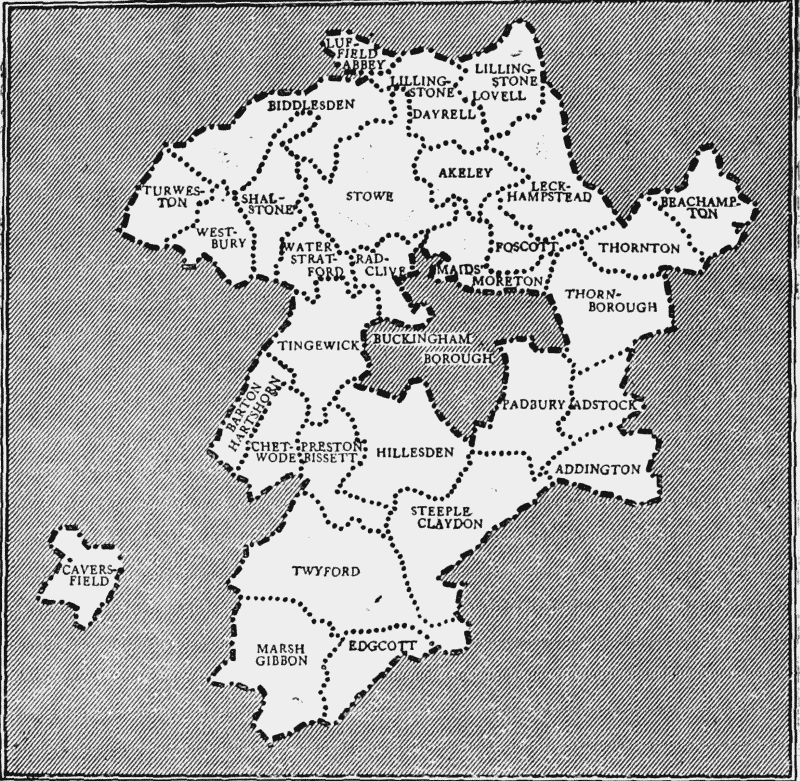A History of the County of Buckingham: Volume 4. Originally published by Victoria County History, London, 1927.
This free content was digitised by double rekeying. All rights reserved.
'Buckingham hundred: Introduction', in A History of the County of Buckingham: Volume 4, ed. William Page (London, 1927), British History Online https://prod.british-history.ac.uk/vch/bucks/vol4/pp135-136 [accessed 23 April 2025].
'Buckingham hundred: Introduction', in A History of the County of Buckingham: Volume 4. Edited by William Page (London, 1927), British History Online, accessed April 23, 2025, https://prod.british-history.ac.uk/vch/bucks/vol4/pp135-136.
"Buckingham hundred: Introduction". A History of the County of Buckingham: Volume 4. Ed. William Page (London, 1927), British History Online. Web. 23 April 2025. https://prod.british-history.ac.uk/vch/bucks/vol4/pp135-136.
THE HUNDRED OF BUCKINGHAM
Containing The Parishes Of Addington; Adstock; Akeley; Barton Hartshorn; Beachampton; Biddlesden; Caversfield (fn. 1) Chetwode; Edgcott; Foscott; Hillesden; Leckhampstead; Lillingstone Dayrell; Lillingstone Lovell; (fn. 2) Luffield Abbey; Maids' Moreton; Marsh Gibbon; Padbury; Preston Bissett; Radclive; Westbury; Shalstone; Steeple Claydon; Stowe; Thornborough; Thornton; Tingewick; Turweston; Twyford with Charndon; And Poundon; Water Stratford;
All the names given above are mentioned in the Domesday Survey, (fn. 3) except Luffield Abbey and Poundon; the latter was probably included under Charndon. Evershaw in Biddlesden, Dadford and Lamport in Stowe, and a hide of land called Hasley were described separately in 1086. (fn. 4)
Buckingham Hundred comprises the three ancient hundreds of Stodfald, Rovelai and Lamva, (fn. 5) which appear grouped as the three hundreds of Buckingham in the later 13th century. (fn. 6) The hundred of Stodfald, assessed in 1086 at 101 hides, (fn. 7) contained the parishes of Akeley, Biddlesden, Foscott, Leckhampstead, Lillingstone Dayrell, Maids' Moreton, Radclive, Shalstone, Stowe, Turweston, Water Stratford and Westbury. The hundred of Rovelai was assessed in 1086 at 105 hides and included the parishes of Barton Hartshorn, Beachampton, Caversfield, Chetwode, Edgcott, Hillesden, Preston Bissett, Thornton and Tingewick. (fn. 8) The hidage of Lamva Hundred, under which the parishes of Addington, Adstock, Marsh Gibbon, Padbury, Steeple Claydon, Thornborough and Twyford were assessed in 1086, covered 122 hides. (fn. 9) Edgcott and Thornton were transferred later from Rovelai to Lamva Hundred. (fn. 10)
In 1625 the royal hundreds of Buckingham (the old names surviving as Stotford, Roulawe and Meanes) (fn. 11) were leased for three lives to Sir Thomas Denton. (fn. 12) In 1651 the rents or certainty money were valued at £23 1s. 1d. yearly; the general perquisites at £10. (fn. 13) These were claimed by Edmund Denton of Hillesden, who did not, however, produce any proof in support of his claim. (fn. 14) In 1661 a petition was made to the Crown for the protection of the rights in this respect of his infant heir, Alexander Denton. (fn. 15) In 1665 the Crown rents from the Buckingham hundreds were granted in dower to Queen Katherine. (fn. 16)
In the middle of the 17th century the court leet was held at the usual times and the ordinary court every three weeks at any convenient place in the hundreds at the will of the lord or his steward. (fn. 17)

Index Map to the Hundred of Buckingham